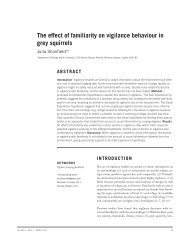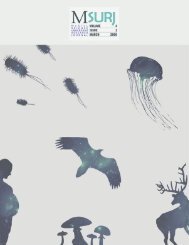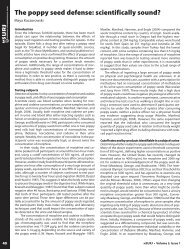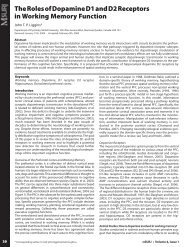the entire issue - McGill Science Undergraduate Research Journal ...
the entire issue - McGill Science Undergraduate Research Journal ...
the entire issue - McGill Science Undergraduate Research Journal ...
You also want an ePaper? Increase the reach of your titles
YUMPU automatically turns print PDFs into web optimized ePapers that Google loves.
Autosomal Recessive Spastic Ataxia of Charlevoix-Saguenay (ARSACS): a once obscure neurodegenerative disease with increasing significance for neurological research<br />
Clinical Features of ARSACS<br />
The clinical features of ARSACS were first reported in 1978 by Bouchard<br />
et al. in a group of French-Canadian patients in Quebec whose<br />
families mostly originated from <strong>the</strong> Charlevoix-Saguenay region,<br />
where around forty families had migrated from Quebec city in <strong>the</strong><br />
1600’s (5). The features were “remarkably homogenous” and were inherited<br />
in an autosomal recessive fashion, distinguishing <strong>the</strong> disease<br />
from most o<strong>the</strong>r classes of ataxia disorders except for Friedreich’s<br />
Ataxia (also autosomal recessive) (5). Subsequent electrophysiological<br />
studies (i.e. electromyography and nerve conduction studies) (10),<br />
as well as brain biopsy studies using light microscopy (11), computed<br />
cerebral tomography (12) and magnetic resonance imaging (13), distinguished<br />
ARSACS from FA by pinpointing <strong>the</strong> anatomical origin of<br />
ARSACS to degeneration of <strong>the</strong> Purkinje neurons in <strong>the</strong> cerebellum,<br />
<strong>the</strong> region responsible for motor coordination and balance.<br />
Clinical manifestation in all ARSACS patients reported by Bouchard<br />
et al. begins with gait unsteadiness observed in toddlers (12 to 18<br />
months old) learning to walk (5). Spasticity (abnormal tensing of<br />
muscles) subsequently develops in <strong>the</strong> peripheries of <strong>the</strong> body and<br />
progressively increases in severity over time, accompanied by peripheral<br />
neuropathy (neuronal degeneration) and amyotrophy (muscle<br />
wasting) (5). The progression of <strong>the</strong> symptoms is much slower<br />
than in o<strong>the</strong>r forms of ataxia and severity of <strong>the</strong> symptoms can remain<br />
stable for a long period of time and suddenly worsen over <strong>the</strong><br />
course of a few years (normally during early adulthood) (5). The individual<br />
is usually wheelchair-bound by <strong>the</strong> age of thirty or forty with<br />
life expectancy reduced to about fifty years of age (5).<br />
The ARSACS Gene<br />
A major turning point in ARSACS research occurred when SACS, <strong>the</strong><br />
gene responsible for <strong>the</strong> disease, was identified by Engert et al. in<br />
2000 via a series of haplotype and linkage analyses and physical gene<br />
mapping among French-Canadian ARSACS patients (7). The gene<br />
was located on <strong>the</strong> long arm of chromosome 13 (13q11) was found<br />
to contain a 12,794-base pair (bp) exon, <strong>the</strong> largest that had been<br />
identified in vertebrates (7). Fur<strong>the</strong>rmore, sequence analysis showed<br />
extensive conservation between mouse and human SACS (14). Population<br />
screening revealed a single base-pair deletion at position 6,594<br />
(6594delT) in most ARSACS patients and a nonsense mutation at position<br />
5254 (5254 C-T) in a small proportion of ARSACS patients (7).<br />
Both mutations were predicted to lead to <strong>the</strong> production of truncated<br />
protein products with <strong>the</strong>ir functions completely abolished (7). These<br />
findings, along with <strong>the</strong> migration history of <strong>the</strong> Chalevoix-Saguenay<br />
(CS) region, attributed <strong>the</strong> prevalence of <strong>the</strong> disease amongst <strong>the</strong> CS<br />
population to <strong>the</strong> increased homozygosity level in <strong>the</strong> population<br />
due to founder effect (7). In addition, though <strong>the</strong> large size of <strong>the</strong><br />
SACS exon makes sequencing an overly expensive and time-consuming<br />
means for diagnosis, several fragment-based sequencing techniques<br />
were developed that could more efficiently identify patients<br />
harboring specific mutations in SACS (15, 16).<br />
“ARSACS Goes Global”<br />
The identification of SACS and advances in genetic linkage study tools<br />
resulted in <strong>the</strong> diagnosis of an increasing number of ARSACS patients<br />
in many o<strong>the</strong>r regions of <strong>the</strong> world. The trend started as early as<br />
in 2000, when several Tunisian patients previously diagnosed with<br />
ano<strong>the</strong>r class of cerebellar ataxia were found to harbor mutations<br />
at loci linked to SACS (17). Since <strong>the</strong>n, many o<strong>the</strong>r ARSACS patient<br />
groups have been identified in Italy (18-20), Japan (21-27), Britain<br />
(28), France (29-31), Spain (32-34), Ne<strong>the</strong>rlands (35) and Belgium (16,<br />
36, 37). All identified ARSACS patients shared <strong>the</strong> core symptoms of<br />
ARSACS (early onset spasticity and ataxia increasing in severity over<br />
time accompanied by dysarthria/slurred speech, nystagmus/vision<br />
impairment and amyotrophy/muscle wasting) despite a few minor<br />
clinical variations, such as later onset and <strong>the</strong> lack of retinal striation<br />
or mental retardation. In fact, <strong>the</strong> trend of globalization is not unique<br />
to ARSACS. Gomez et al. pointed out in an editorial that <strong>the</strong> “spreading”<br />
of ARSACS embodies a prevailing trend in <strong>the</strong> realm of neurological<br />
diseases: Several recessive neurological disorders originally<br />
considered to be restricted to a particular ethnic group or geographical<br />
location were later found to be present in many o<strong>the</strong>r populations<br />
around <strong>the</strong> world and Gomez et al. predicted that more neurological<br />
diseases were to follow suit (38).<br />
With <strong>the</strong> identification of ARSACS patients worldwide, an increasing<br />
number of mutations in SACS were also revealed. To date, over 70 SACS<br />
mutations have been discovered in 13 countries (6). It is interesting<br />
to note that founder effect seems to play a role only in <strong>the</strong> Quebec patient<br />
population (6). Most of <strong>the</strong> currently identified SACS mutations<br />
are frameshift or nonsense point mutations residing within <strong>the</strong> exon<br />
(13, 16, 18, 19, 21-24, 36, 39-44) identified by Engert et al. However, <strong>the</strong><br />
discovery of several point mutations and macrodeletions upstream<br />
of <strong>the</strong> exon in ARSACS patients (13, 16, 20, 25, 36, 40, 45) led to <strong>the</strong><br />
upstream extension of <strong>the</strong> putative SACS gene to contain eight additional<br />
exons (6). In 2009, reverse transcriptase-polymerase chain<br />
reaction (RT-PCR) analysis of human brain mRNA, in conjunction<br />
with nor<strong>the</strong>rn blot analysis and in-situ hybridization on a number<br />
of human t<strong>issue</strong>s, confirmed that <strong>the</strong> SACS encodes a nine-exon transcript<br />
that is expressed in a variety of t<strong>issue</strong>s including fibroblasts,<br />
skeletal muscle and <strong>the</strong> brain, particularly in <strong>the</strong> Purkinje cells of <strong>the</strong><br />
cerebellum (46).<br />
The Sacsin Protein<br />
The gene product of SACS in human is a relatively large protein (~4500<br />
amino acids) named sacsin (8). Based on its amino acid sequence,<br />
<strong>the</strong> secondary structure of sacsin has been predicted to consist of<br />
70<br />
<strong>McGill</strong> <strong>Science</strong> <strong>Undergraduate</strong> <strong>Research</strong> <strong>Journal</strong> - msurj.mcgill.ca









